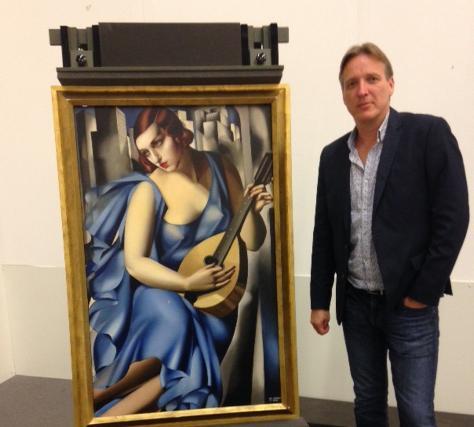How art detective Arthur Brand recovered two multi-million pound pieces of stolen art
'I once had to negotiate the return of a painting in Mafia'

Described as a “super sleuth” and art detective by the press, Arthur Brand is Holland’s very own Raider of Lost Art. The paintings, Salvador Dali's 1941 Surrealist work Adolescence and Polish Art Deco painter Tamara de Lempicka’s La Musicienne (1929), which featured in Madonna’s “Vogue” music video, had been thought destroyed forever.
But, after nine months of careful negotiations with two separate criminal gangs in possession of the haul worth an estimated £6.5 million, Brand secured their return. This is far from his biggest success, having last year duped a group with Nazi sympathies into revealing the whereabouts of two massive bronze horse sculptures commissioned by Adolf Hitler which history books stated were destroyed during World War Two.
The works by sculptor Joseph Thorak had flanked the doorway of Hitler’s Reichstag building and had been believed bombed for 70 years until Brand identified them.
Sleuthing is not Brand’s day job; his company advises collectors on the provenance of art and antiquities. So, having seen enough evidence (using a mixture of military contacts, satellite images and German archives) to believe that the horses being touted were indeed the original Nazi Thoraks and not fakes, he invented a very rich American buyer based on JR from Dallas, made enquiries and gathered enough information to tip off German police, who had already been investigating illegal art trafficking, and they discovered the pieces among a cache of looted art in the southwestern spa town of Bad Duerkheim.
“What I do with my company is we advise collectors to prevent them from buying forgeries. That’s about 70 per cent of my work. The rest of the time we work with Jewish families to recover works from their collections stolen by the Nazis. But a small part of our work is recoveries of thefts, and these are the things that hit the headlines, these huge cases,” Brand says over the phone from Holland.
Brand began his sideline in 2002. He had been a collector himself and was soon stung by the realisation he’d invested in forgeries. He befriended notorious Dutch art smuggler Michel van Rijn, who had since been working with police as an informant, who invited him to London where he was working with Scotland Yard, the FBI and a number of high profile fakers and antiquities smugglers. Van Riijn took a liking to Brand and passed on a wealth of information. “So I was launched from day one into the top of this pyramid,” Brand says, with a laugh
He believes that 30 per cent of the pieces officially sold through the mainstream art market are forgeries.
But knowing a forgery and uncovering a picture that has been taken by masked thieves carrying guns is quite another thing. “Only 5 per cent of stolen artworks are recovered,” he says. “It’s very hard because if the criminals believe the police are catching up with them they will destroy the artwork, the evidence. Of course it is very important to catch these thieves, to stop them. But this hot art is passed on on very quickly and in one or two years in most cases the person in possession of the art has no idea who has done the robbery. Because there are so many scales between them. So, then the most important thing is to get the paintings back.”
The Dali and Lempicka paintings had changed hands 10 times between 2009 when they were stolen from the Scheringa Museum of Realist Art in Spanbroek, and last week when they were handed to Brand wrapped in an old blanket. So how did he get them back? The criminal gang in possession of them didn’t want them; they’d been given to them, he presumes by other drugs gangs, in lieu of payment. The gang with the debt hadn’t made good on their payment and the others had been left with paintings they couldn’t sell. This happened several times until one of Brand’s contacts got in touch and they made a deal: we’ll give you the paintings if you take them no questions asked and there are no repercussions for us.
“These criminals steal art because they have seen the James Bond movie Dr. No and they think that there are rich collectors who would like to buy a stolen painting. But these Dr. Nos do not exist,” he says. “But there are organisations that do artnapping for different reasons, like the IRA, which in the ‘90s used art thefts as a kind of blackmail. It was an insurance policy so as soon as they got caught they could negotiate about returning the painting and try to get a deal. It’s the same with the Mafia, the Italian mafia, which is also a very huge participant in the art crime.”
"I once had to negotiate the return of a painting in Mafia. I didn’t succeed but the negotiation, the deal the mafia wanted, was to get better phone access for their partners in jail so they could have an hour a week on the phone from their cells."
Brand doesn’t see himself as particularly heroic and says his role is as simple as bridging the world between criminals and the police through communication and building trust. “You soon find out when you dig into it that these are not serial killers. These are not people walking around at night killing random people. These are people who kill when they see a need for it. So of course I have to keep my word when I give it to them. Because if I don’t I might be in serious trouble.”
- More about:
- art
- Arthur Brand

